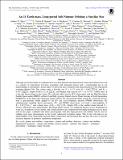An 11 Earth-mass, long-period sub-Neptune orbiting a Sun-like star
Abstract
Although several thousands of exoplanets have now been detected and characterized, observational biases have led to a paucity of long-period, low-mass exoplanets with measured masses and a corresponding lag in our understanding of such planets. In this paper we report the mass estimation and characterization of the long-period exoplanet Kepler-538b. This planet orbits a Sun-like star (V = 11.27) with M ⊙= 0.892 +/- (0.051, 0.035) and R ⊙ = 0.8717 +/- (0.0064, 0.0061). Kepler-538b is a 2.215 +/- (0.040, 0.034) R ⊕ sub-Neptune with a period of P = 81.73778 ± 0.00013 days. It is the only known planet in the system. We collected radial velocity (RV) observations with the High Resolution Echelle Spectrometer (HIRES) on Keck I and High Accuracy Radial velocity Planet Searcher in North hemisphere (HARPS-N) on the Telescopio Nazionale Galileo (TNG). We characterized stellar activity by a Gaussian process with a quasi-periodic kernel applied to our RV and cross-correlation function FWHM observations. By simultaneously modeling Kepler photometry, RV, and FWHM observations, we found a semi-amplitude of K = 1.68 +/- (0.39, 0.38) m s−1 and a planet mass of Mp = 10.6 +/- (2.5, 2.4)M ⊕. Kepler-538b is the smallest planet beyond P = 50 days with an RV mass measurement. The planet likely consists of a significant fraction of ices (dominated by water ice), in addition to rocks/metals, and a small amount of gas. Sophisticated modeling techniques such as those used in this paper, combined with future spectrographs with ultra high-precision and stability will be vital for yielding more mass measurements in this poorly understood exoplanet regime. This in turn will improve our understanding of the relationship between planet composition and insolation flux and how the rocky to gaseous transition depends on planetary equilibrium temperature.
Citation
Mayo , A W , Rajpaul , V M , Buchhave , L A , Dressing , C D , Mortier , A , Zeng , L , Fortenbach , C D , Aigrain , S , Bonomo , A S , Cameron , A C , Charbonneau , D , Coffinet , A , Cosentino , R , Damasso , M , Dumusque , X , Fiorenzano , A F M , Haywood , R D , Latham , D W , López-Morales , M , Malavolta , L , Micela , G , Molinari , E , Pearce , L , Pepe , F , Phillips , D , Piotto , G , Poretti , E , Rice , K , Sozzetti , A & Udry , S 2019 , ' An 11 Earth-mass, long-period sub-Neptune orbiting a Sun-like star ' , Astronomical Journal , vol. 158 , no. 4 , 165 . https://doi.org/10.3847/1538-3881/ab3e2f
Publication
Astronomical Journal
Status
Peer reviewed
ISSN
0004-6256Type
Journal article
Description
The HARPS-N project has been funded by the Prodex Program of the Swiss Space Office (SSO), the Harvard University Origins of Life Initiative (HUOLI), the Scottish Universities Physics Alliance (SUPA), the University of Geneva, the Smithsonian Astrophysical Observatory (SAO), and the Italian National Astrophysical Institute (INAF), the University of St Andrews, Queens University Belfast, and the University of Edinburgh.Collections
Items in the St Andrews Research Repository are protected by copyright, with all rights reserved, unless otherwise indicated.
Related items
Showing items related by title, author, creator and subject.
-
Precise masses in the WASP-47 system
Vanderburg, Andrew; Becker, Juliette C.; Buchhave, Lars A.; Mortier, Annelies; Lopez, Eric; Malavolta, Luca; Haywood, Raphaëlle D.; Latham, David W.; Charbonneau, David; López-Morales, Mercedes; Adams, Fred C.; Bonomo, Aldo Stefano; Bouchy, François; Collier Cameron, Andrew; Cosentino, Rosario; Di Fabrizio, Luca; Dumusque, Xavier; Fiorenzano, Aldo; Harutyunyan, Avet; Johnson, John Asher; Lorenzi, Vania; Lovis, Christophe; Mayor, Michel; Micela, Giusi; Molinari, Emilio; Pedani, Marco; Pepe, Francesco; Piotto, Giampaolo; Phillips, David; Rice, Ken; Sasselov, Dimitar; Ségransan, Damien; Sozzetti, Alessandro; Udry, Stéphane; Watson, Chris (2017-11-17) - Journal articleWe present precise radial velocity observations of WASP-47, a star known to host a hot Jupiter, a distant Jovian companion, and, uniquely, two additional transiting planets in short-period orbits: a super-Earth in a ≈19 ... -
Three newly discovered sub-Jupiter-mass planets : WASP-69b and WASP-84b transit active K dwarfs and WASP-70Ab transits the evolved primary of a G4+K3 binary
Anderson, D. R.; Cameron, A. Collier; Delrez, L.; Doyle, A. P.; Faedi, F.; Fumel, A.; Gillon, M.; Chew, Y. Gomez Maqueo; Hellier, C.; Jehin, E.; Lendl, M.; Maxted, P. F. L.; Pepe, F.; Pollacco, D.; Queloz, D.; Segransan, D.; Skillen, I.; Smalley, B.; Smith, A. M. S.; Southworth, J.; Triaud, A. H. M. J.; Turner, O. D.; Udry, S.; West, R. G. (2014-12-01) - Journal articleWe report the discovery of the transiting exoplanets WASP-69b, WASP-70Ab and WASP-84b, each of which orbits a bright star (V ∼ 10). WASP-69b is a bloated Saturn-mass planet (0.26 MJup, 1.06 RJup) in a 3.868-d period around ... -
The well-aligned orbit of Wasp-84b : evidence for disk migration of a hot Jupiter
Anderson, D. R.; Triaud, A. H. M. J.; Turner, O. D.; Brown, D. J. A.; Clark, B. J. M.; Smalley, B.; Cameron, A. Collier; Doyle, A. P.; Gillon, M.; Hellier, C.; Lovis, C.; Maxted, P. F. L.; Pollacco, D.; Queloz, D.; Smith, A. M. S. (2015-02-10) - Journal articleWe report the sky-projected orbital obliquity (spin–orbit angle) of WASP-84 b, a 0.69 planet in an 8.52 day orbit around a G9V/K0V star, to be λ = −0.3 ± 1.7°. We obtain a true obliquity of ψ = 17.3 ± 7.7° from a measurement ...

